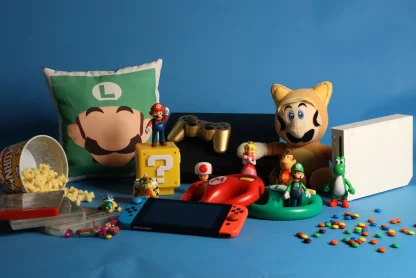In today’s fast-paced and hyperconnected world, the concept of “digital detox” has emerged as a powerful remedy to combat the overwhelming influence of technology on our lives. This article, “How to Disconnect to Reconnect: Why Digital Detox Is Vital for Your Happiness,” delves into the importance of embracing a digital detox and its profound impact on our overall well-being and happiness. By exploring the detrimental effects of excessive screen time, providing practical tips on how to disconnect from digital devices, and highlighting the transformative benefits of this practice, we aim to guide readers towards a healthier and more balanced relationship with technology. Join us on this journey as we unlock the key to reclaiming our time, fostering deeper connections, and nurturing our own happiness through the power of a digital detox.
Table of Contents
- Understanding the effects of excessive screen time on mental health
- The benefits of taking a digital detox
- How to Take a Digital Detox
- How to set boundaries around technology use
- Finding alternative ways to connect with others offline
- Practicing mindfulness to reduce the impact of technology on mental health
- The role of social media in mental health and wellbeing
- Strategies for reducing dependence on technology
- The impact of technology on sleep and how to improve sleep hygiene
- Incorporating tech-free time into daily routines
- The importance of self-care and balance in the digital age
- Frequently Asked Questions

Understanding the effects of excessive screen time on mental health
The research on screen time and mental health
Numerous studies have investigated the relationship between screen time and mental health. A study published found that children who spent more than two hours a day on screens had lower scores on cognitive tests, language, and memory skills than those who spent less time on screens. Another study published found that adults who spent more than four hours a day on screens had higher levels of depressive symptoms, anxiety, and stress than those who spent less time on screens.
The potential negative effects of excessive screen time and why digital detox is important
Excessive screen time has been linked to a range of negative effects on mental health.
Some of these include:
Poor sleep
Screens emit blue light that can disrupt our sleep-wake cycle, making it harder to fall asleep and stay asleep. This can lead to chronic sleep deprivation, which has been linked to a range of mental health problems, including depression, anxiety, and irritability.
Social isolation
Spending too much time on screens can also lead to social isolation, as it reduces opportunities for face-to-face interaction with friends, family, and community. This can contribute to feelings of loneliness, which has been linked to poor mental health outcomes.
Addiction
Screen time can be addictive, and excessive use of screens has been linked to the same brain changes as drug addiction. This can lead to withdrawal symptoms when screens are taken away, which can further exacerbate mental health problems.
Reduced attention span
Excessive screen time is linked to reduced attention span and difficulty concentrating. This can interfere with academic or work performance and lead to frustration and low self-esteem.
Tips for reducing screen time to protect your mental well-being
Reducing screen time can be challenging, especially in a world where screens are ubiquitous.
However, there are several strategies you can use to protect your mental well-being:
Set boundaries
Set limits on your screen time, whether it’s a specific number of hours per day or designated times when screens are off-limits, such as during meals or before bedtime.
Prioritize face-to-face interactions
Make an effort to prioritize face-to-face interactions with loved ones and community, whether it’s meeting up for coffee or joining a club or group that shares your interests.
Engage in other activities while digital detox
Find other activities that you enjoy and that don’t involve screens, such as exercise, hobbies, or outdoor activities.
Practice mindfulness
Take breaks throughout the day to engage in mindfulness practices such as deep breathing, meditation, or yoga. This can help reduce stress and anxiety and increase feelings of well-being.
Excessive screen time has become a ubiquitous part of modern life, but it’s important to be aware of the potential negative effects it can have on mental health. By understanding the research on the relationship between screen time and mental health, recognizing the potential negative effects of excessive screen time, and implementing strategies to reduce screen time, we can protect our mental well-being and lead healthier, more balanced lives.
The benefits of taking a digital detox
In today’s digital age, it is easy to become consumed by technology. Our constant need to be connected can lead to stress, anxiety, and even addiction. Taking a break from technology, also known as a digital detox, can have many benefits for our mental health and overall well-being. Here, we will explore the benefits of taking a digital detox and how to do it effectively.
Improved sleep
One of the most significant benefits of taking a digital detox is improved sleep. The blue light emitted by screens can disrupt our circadian rhythm and make it difficult to fall asleep. By disconnecting from technology, we give our brains a chance to wind down, and our bodies can naturally regulate our sleep cycle.
Reduced stress and anxiety
Excessive screen time can lead to increased stress and anxiety. Constant notifications and the pressure to be constantly available can take a toll on our mental health. Taking a digital detox can give us a break from this constant stimulation and allow us to focus on other things, such as spending time with loved ones or pursuing hobbies.
Improved productivity
Taking a break from technology can help us be more productive in the long run. When we are constantly distracted by our devices, it can be challenging to focus on important tasks. By stepping away from technology, we give ourselves the opportunity to clear our minds and prioritize our goals.
Increased mindfulness
Mindfulness is the practice of being present at the moment and fully engaged in the task at hand. Taking a digital detox can help us cultivate mindfulness by giving us the space to be fully present and engaged with our surroundings. By disconnecting from technology, we can focus on the present moment and be more intentional with our time.
Improved relationships
Excessive screen time can take a toll on our relationships with others. When we are constantly glued to our devices, we may miss out on meaningful interactions with our loved ones. Taking a digital detox can help us prioritize our relationships and make time for the people who matter most.
How to Take a Digital Detox
Now that we understand the benefits of taking a digital detox, let’s explore how to do it effectively.
Set boundaries
Start by setting clear boundaries around your technology use. Decide when and where you will disconnect and communicate your plans with friends and family.
Find alternative activities
Fill your time with alternative activities that bring you joy, such as spending time in nature, reading a book, or practicing yoga.
Use apps to help digital detox
There are many apps available that can help you disconnect, such as Moment and Forest. These apps can help you track your screen time and encourage you to take breaks.
Engage in social support
Surround yourself with people who support your digital detox goals. Consider joining a support group or partnering up with a friend who is also taking a break from technology.
Practice self-compassion
Remember that taking a digital detox is not easy, and it is okay to slip up. Practice self-compassion and be gentle with yourself throughout the process.
Taking a digital detox can have many benefits for our mental health and overall well-being. By disconnecting from technology, we can improve our sleep, reduce stress and anxiety, increase productivity, cultivate mindfulness, and improve our relationships with others. To take a successful digital detox, it’s important to set boundaries, find alternative activities, use apps to help, engage in social support, and practice self-compassion.
How to set boundaries around technology use
Technology has become an integral part of our lives, with smartphones, tablets, and computers providing us with constant access to information and entertainment. While technology has many benefits, it can also be addictive and harmful to our mental health when we don’t set boundaries around our use.
Recognize the Need for Boundaries
The first step in setting boundaries around technology use is recognizing the need for them. Constantly checking your phone, browsing social media, and playing video games for hours on end can interfere with your ability to focus, sleep, and maintain healthy relationships. Research has linked excessive technology use to increased stress, anxiety, and depression, so it’s important to take steps to protect your mental health.
Identify Your Triggers
Next, identify your triggers for technology use. Are you most likely to reach for your phone when you’re bored, anxious, or stressed? Once you know your triggers, you can create a plan to address them, such as taking a walk, practicing mindfulness, or engaging in a relaxing activity instead of reaching for your device.
Set Clear Boundaries
Setting clear boundaries is key to reducing your technology use. Start by deciding when and where you will use your devices, and stick to those limits. For example, you might decide to avoid screens for an hour before bed or to turn off notifications during meals or family time.
Communicate Your Boundaries
It’s important to communicate your boundaries with others, especially if they share your living space. Let your family and friends know when you will be using your devices and when you won’t, so they can respect your boundaries and help hold you accountable.
Use Tools to Help You Track Your Digital Detox Journey
There are many tools available to help you stay on track with your technology use boundaries. For example, you might use an app to track your screen time or limit your access to certain websites or apps during designated times of the day.
Practice Self-Care
Setting boundaries around technology use is just one aspect of self-care. It’s important to take care of your physical and emotional needs as well, such as getting enough sleep, exercise, and social interaction. Taking care of yourself in these ways can help reduce the urge to use technology as a coping mechanism.
Be Flexible
Remember that setting boundaries is not about perfection, but about creating a balance that works for you. It’s okay to adjust your boundaries as needed, and to be flexible if unexpected events arise. The goal is to create a sustainable plan that promotes your mental health and well-being.
A study found that limiting social media use to 30 minutes per day significantly reduced feelings of loneliness and depression in young adults. The study also found that the effects of the intervention were strongest for those who reported high levels of depression at the beginning of the study. This suggests that setting boundaries around technology use can have a significant positive impact on mental health, especially for those who are struggling with depression or other mental health issues.
Setting boundaries around technology use is essential for protecting your mental health and well-being. By recognizing the need for boundaries, identifying your triggers, setting clear limits, communicating with others, using tools to help you stay on track, practicing self-care, and being flexible, you can create a sustainable plan that promotes a healthy balance between technology use and other aspects of your life. Remember that it’s okay to ask for help and support if you’re struggling to set and maintain boundaries around technology use.
Finding alternative ways to connect with others offline
In today’s world, technology has become an integral part of our lives, allowing us to connect with others anytime and anywhere. While this has its benefits, excessive use of technology and social media can lead to feelings of loneliness and disconnection. Finding alternative ways to connect with others offline can be an effective solution for combating these feelings and improving mental health.
The Importance of Offline Connections
While online connections can be convenient and useful, research has shown that offline connections are essential for our well-being. A study found that face-to-face interactions are more likely to lead to positive emotions and reduce feelings of loneliness compared to online interactions.
Engaging in Group Activities
Engaging in group activities that interest you can be an effective way to connect with others offline. Joining a book club, volunteering at a local organization, or participating in a sports team are all great ways to meet new people who share your interests.
Attend Local Events
Attending local events such as farmers’ markets, concerts, or festivals can provide opportunities to meet new people and connect with the community. Local events can also offer a chance to explore new interests and hobbies, leading to personal growth and fulfillment.
Practice Active Listening
When connecting with others offline, it’s essential to practice active listening. Listening attentively and responding thoughtfully can help build deeper connections and promote empathy and understanding.
Prioritize Face-to-Face Interactions
While online connections can be convenient, it’s important to prioritize face-to-face interactions whenever possible. Making plans to meet up with friends or family in person, rather than solely communicating through technology, can help build stronger connections and promote a sense of belonging.
Explore Nature
Spending time in nature has been shown to improve mental health and well-being. Exploring natural settings, such as hiking trails, parks, or beaches, can be an effective way to disconnect from technology and connect with others offline.
Start a Hobby Group
Starting a hobby group can be a great way to connect with others offline who share similar interests. Whether it’s a knitting circle, a cooking class, or a photography club, having a shared activity can provide a sense of community and belonging.
Practice Mindful Communication
When communicating offline, practicing mindful communication can promote deeper connections and reduce misunderstandings. This involves actively listening, speaking honestly and respectfully, and being open to other’s perspectives and experiences.
Finding alternative ways to connect with others offline is essential for promoting mental health and well-being. Whether it’s engaging in group activities, attending local events, or exploring nature, prioritizing face-to-face interactions and practicing mindful communication can help build deeper connections and combat feelings of loneliness and disconnection.
Practicing mindfulness to reduce the impact of technology on mental health
In today’s fast-paced world, technology has become an integral part of our lives. From smartphones and laptops to social media and video games, we are constantly surrounded by digital devices and platforms. While technology has undoubtedly made our lives easier and more efficient, it has also led to an increase in mental health problems such as anxiety, depression, and stress. This is where mindfulness comes in as a powerful tool to reduce the impact of technology on our mental health.
What is mindfulness?
Mindfulness is the practice of being present and fully engaged in the moment, without judgment or distraction. It involves attending to thoughts, feelings, physical sensations, and the world with openness and curiosity. Mindfulness benefits mental and physical health by reducing stress, anxiety, and improving cognitive function and emotional regulation.
The impact of technology on mental health
Technology revolutionized communication, work, and play, but negatively impacted mental health. Studies reveal that excessive digital device use causes mental health issues: addiction, depression, anxiety, and sleep disorders. A study linked more social media use to anxiety and depression. Another associated pre-bedtime smartphone use with disrupted sleep and daytime fatigue.
How mindfulness can reduce the impact of technology on mental health
Practicing mindfulness can help reduce the negative impact of technology on mental health in several ways:
Reduce stress and anxiety
Mindfulness has been shown to reduce stress and anxiety by promoting relaxation and calming the nervous system. Through mindfulness, we recognize and manage stress triggers like excessive social media or email notifications.
Enhance emotional regulation
Mindfulness can also help improve our emotional regulation, allowing us to better manage our reactions to the stimuli around us. Mindfulness helps manage negative emotions caused by technology, like frustration with slow internet or anger at social media comments.
Improve cognitive function
Studies have shown that mindfulness can improve cognitive function, including attention, memory, and decision-making. By practicing mindfulness, we can improve our ability to focus on important tasks and avoid distractions from digital devices.
Enhance sleep quality
Mindfulness has been shown to improve sleep quality by reducing stress and promoting relaxation. By practicing mindfulness before bed, we can improve our sleep patterns and reduce the negative impact of technology on our sleep.
Study on mindfulness and technology
A study found that mindfulness training can reduce the negative impact of technology on mental health. The study involved university students who were randomly assigned to either a mindfulness group or a control group. The mindfulness group received eight weeks of mindfulness training, while the control group did not receive any training. Participants in both groups were asked to complete a questionnaire assessing their levels of anxiety, depression, and stress before and after the study.
In the study, the mindfulness group had significantly lower levels of anxiety, depression, and stress than the control group. The study concluded mindfulness training is effective in reducing tech’s negative impact on mental health.
Technology has become an integral part of our lives, but it can also have a negative impact on our mental health. Mindfulness reduces tech’s negative impact on mental health. It reduces stress, anxiety, enhances emotional regulation, cognitive function, and sleep quality. The study discussed above provides evidence that mindfulness training can be an effective tool for reducing the negative impact of technology on mental health. By incorporating mindfulness into our daily lives, we can better manage the impact
Setting boundaries around technology use is just one aspect of self-care. It’s important to take care of your physical and emotional needs as well, such as getting enough sleep, exercise, and social interaction
The role of social media in mental health and wellbeing
Positive effects of social media on mental health and well-being
Social support
Social media can provide a sense of social support and connection, which is essential for mental health and well-being. For example, social media can allow people to connect with others who share similar experiences or challenges, such as chronic illness or mental health issues.
Awareness and education
Social media can also raise awareness and education around mental health issues, reducing stigma and providing a platform for sharing information and resources.
Positive content
Social media can be a source of positive content, such as inspirational quotes, uplifting stories, and messages of hope and resilience.
Negative effects of social media on mental health and well-being
Social comparison
Social media can create an environment of social comparison, where users compare their lives to others’ curated and often idealized online personas, leading to feelings of inadequacy, low self-esteem, and anxiety.
Cyberbullying
Social media can facilitate cyberbullying, which can have a devastating impact on mental health and well-being, leading to depression, anxiety, and even suicide.
Addiction
Social media can be addictive, with users feeling the need to constantly check and engage with social media platforms, leading to reduced productivity, lack of focus, and disrupted sleep patterns.
A study found a significant relationship between social media use and depression among young adults. The study involved 1,787 adults aged 19-32 who completed a survey assessing their social media use and symptoms of depression.
The results of the study showed that participants who reported using social media for more than two hours per day had a higher likelihood of reporting symptoms of depression compared to those who reported using social media for less than 30 minutes per day. Additionally, participants who reported that social media made them feel “more isolated” also had a higher likelihood of reporting symptoms of depression.
Social media can have both positive and negative effects on mental health and well-being. While social media can provide a sense of social support, raise awareness and education around mental health issues, and be a source of positive content, it can also lead to social comparison, cyberbullying, and addiction. The study discussed above provides evidence that excessive social media use can increase the risk of depression among young adults. It is important to approach social media use mindfully and with awareness, focusing on the positive aspects while minimizing the negative impact on our mental health and well-being.
Strategies for reducing dependence on technology
Set boundaries
One of the most effective ways to reduce dependence on technology is to set boundaries around its use. This could include limiting the amount of time spent on devices, setting designated times for checking emails or social media, and turning off notifications when not needed.
Practice mindfulness
Mindfulness is the practice of being fully present and aware of our thoughts and feelings in the present moment. By practicing mindfulness, we can become more aware of our dependence on technology and develop healthier habits around its use.
Engage in offline activities
Spending time engaged in offline activities can help reduce dependence on technology. This could include hobbies, exercise, spending time with friends and family, or simply taking a walk in nature.
Use technology for positive purposes
While technology can become a source of dependence, it can also be used for positive purposes, such as learning new skills or staying connected with loved ones. By focusing on the positive aspects of technology, we can reduce its negative impact on our lives.
Study on Technology dependence
A study found that individuals who reported high levels of smartphone addiction also reported higher levels of anxiety and depression. The study involved undergraduate students who completed surveys assessing their levels of smartphone addiction, anxiety, and depression.
The results of the study showed that participants who reported higher levels of smartphone addiction had significantly higher levels of anxiety and depression compared to those who reported lower levels of smartphone addiction. Additionally, the study found that the negative impact of smartphone addiction on mental health was greater for individuals who reported lower levels of self-control.
Reducing dependence on technology can have a positive impact on our mental health and well-being. By setting boundaries around technology use, practicing mindfulness, engaging in offline activities, and focusing on the positive aspects of technology, we can reduce its negative impact on our lives. The study discussed above provides evidence that excessive smartphone use can lead to increased levels of anxiety and depression, highlighting the importance of reducing dependence on technology for our mental health. By implementing these strategies, we can develop a healthier relationship with technology and improve our overall well-being.
The impact of technology on sleep and how to improve sleep hygiene
Blue light and sleep
Exposure to blue light emitted by electronic devices, such as smartphones and laptops, can interfere with the body’s natural sleep-wake cycle. Blue light suppresses the production of melatonin, a hormone that regulates sleep. As a result, it can take longer to fall asleep, and sleep quality can be reduced.
Disrupting sleep patterns
Using technology before bedtime can disrupt sleep patterns and lead to sleep deprivation. The content we consume on our devices can be stimulating, making it harder to relax and fall asleep. Additionally, the noise and notifications from electronic devices can disrupt our sleep and cause us to wake up throughout the night.
Impact on mental health
Sleep deprivation caused by technology use can also have a negative impact on mental health. Lack of sleep can lead to anxiety, depression, and other mental health problems. Additionally, the constant use of technology can contribute to feelings of stress and anxiety.
Tips for improving sleep hygiene
Limit technology use before bedtime
To improve sleep hygiene, it is recommended to limit technology use before bedtime. This means avoiding the use of electronic devices, such as smartphones and laptops, for at least an hour before going to bed. Instead, engage in relaxing activities, such as reading a book or taking a bath.
Use blue light filters
Using blue light filters on electronic devices can reduce exposure to blue light and promote better sleep. Many devices have built-in blue light filters, and there are also apps and software available that can be downloaded to reduce blue light exposure.
Establish a sleep routine
Establishing a regular sleep routine can help improve sleep hygiene. This means going to bed and waking up at the same time each day, even on weekends. This helps regulate the body’s internal clock and can improve sleep quality.
Create a sleep-conducive environment
Creating a sleep-conducive environment can also improve sleep hygiene. This means keeping the bedroom cool, dark, and quiet, and removing any electronic devices from the bedroom.
A study found that increased technology use was associated with poor sleep quality among adolescents. The study involved 1,537 adolescents who completed surveys assessing their technology use and sleep quality.
The results of the study showed that higher levels of technology use were associated with poorer sleep quality. Additionally, the study found that adolescents who reported using electronic devices in their bedrooms had significantly worse sleep quality compared to those who did not use devices in their bedrooms.
The impact of technology on sleep quality is a growing concern. The blue light emitted by electronic devices can interfere with the body’s natural sleep-wake cycle, disrupting sleep patterns and leading to sleep deprivation. The constant use of technology can also contribute to feelings of stress and anxiety, leading to further negative effects on mental health. By implementing tips for improving sleep hygiene, such as limiting technology use before bedtime and establishing a regular sleep routine, we can improve our sleep quality and overall well-being. The study discussed above provides evidence that increased technology use is associated with poorer sleep quality, highlighting the importance of taking steps to reduce our dependence on technology for the sake of our sleep and health.
Incorporating tech-free time into daily routines
Benefits of digital detox
Taking a break from technology can have many benefits. It can help to reduce stress and anxiety, improve sleep quality, increase productivity, and enhance our relationships with others. By disconnecting from technology, we can engage in activities that promote relaxation and mindfulness, such as reading a book, spending time in nature, or practicing yoga.
Setting boundaries
One way to incorporate tech-free time into our daily routines is to set boundaries around technology use. This could mean turning off electronic devices during meals, designating certain times of the day for checking emails and social media, and establishing a cut-off time for technology use in the evenings.
Planning activities
Planning tech-free activities can also help to reduce dependence on technology. This could include scheduling time for exercise, hobbies, or socializing with friends and family. By intentionally scheduling activities that do not involve technology, we can create space for self-care and relaxation.
Finding alternatives
Finding alternatives to technology can also be helpful in reducing dependence on it. This could include engaging in analog activities such as writing with pen and paper, listening to music on vinyl records, or reading physical books instead of e-books.
A study found that taking a break from Facebook for just five days can lead to improved well-being. The study involved 1,095 participants who were randomly assigned to either continue using Facebook as usual or take a break from the platform for five days.
The results of the study showed that participants who took a break from Facebook reported significantly higher levels of life satisfaction and lower levels of negative emotions compared to those who continued to use the platform. Additionally, the study found that the effects of the Facebook break persisted for up to two weeks after the intervention.
Incorporating tech-free time into our daily routines can have many benefits for our physical and mental well-being. Setting boundaries around technology use, planning tech-free activities, and finding alternatives to technology can all help to reduce dependence on it. The study discussed above provides evidence that taking a break from technology can lead to improved well-being, highlighting the importance of incorporating tech-free time into our daily routines. By intentionally creating space for self-care and relaxation, we can improve our overall quality of life and reduce the negative impact of technology on our well-being.
The importance of self-care and balance in the digital age
In today’s hyper-connected world, the allure of digital devices and constant online engagement has become almost irresistible. We find ourselves glued to screens, constantly checking notifications, and losing track of time. However, amidst this digital frenzy, it’s essential to remember the significance of self-care and balance. Disconnecting from our digital lives and taking time to focus on ourselves is crucial for our overall well-being and happiness.
The Impact of Digital Overload
Excessive use of digital devices and the constant barrage of information can have detrimental effects on our mental, emotional, and even physical health. Studies have shown that prolonged screen time can lead to increased stress, anxiety, and a decrease in overall life satisfaction. The constant exposure to curated online lives can also contribute to feelings of inadequacy and comparison, affecting our self-esteem.
The Importance of Self-Care
Self-care involves consciously setting aside time to engage in activities that promote our physical, mental, and emotional well-being. In the digital age, self-care becomes even more vital. It allows us to recharge, reflect, and rejuvenate, enabling us to navigate the digital landscape more effectively.
Benefits of Digital Detox
Disconnecting from our devices for designated periods can have numerous benefits. It provides an opportunity to engage in activities that bring us joy and fulfillment, such as spending quality time with loved ones, pursuing hobbies, or simply enjoying the beauty of the natural world. Detoxing from technology allows us to reconnect with ourselves, reducing stress levels and promoting mental clarity. Additionally, it can improve sleep quality, enhance productivity, and foster deeper connections in our relationships.
Striking a Balance
Achieving a healthy balance between our digital lives and self-care activities is crucial. Setting boundaries around our device usage, such as implementing tech-free zones or designated screen-free hours, can help create a sense of control over our digital consumption. Engaging in mindful activities such as meditation, yoga, or journaling can also aid in finding balance and grounding ourselves in the present moment.
Supporting Study
A study explored the effects of a digital detox on well-being. The study involved a group of participants who voluntarily disconnected from their digital devices for a week. The findings revealed a significant increase in happiness levels and a reduction in stress and anxiety among the participants. The study further emphasized the importance of disconnecting from the digital world to reconnect with oneself and foster happiness.
In the digital age, it is crucial to prioritize self-care and balance to maintain our overall well-being and happiness. Taking regular breaks from digital devices and engaging in activities that nurture our physical, mental, and emotional health can lead to a more fulfilling life. By disconnecting from the digital world, we can reconnect with ourselves and the world around us, fostering a sense of inner peace and contentment in an increasingly interconnected world.
Frequently Asked Questions
To incorporate a digital detox into work, plan, communicate, and set boundaries. Schedule specific disconnect times, prioritize self-care, and inform others using automated email responses or voicemail greetings. Implement technology boundaries during work hours, such as disabling non-essential notifications. Balancing detox and work enables disconnection and a strong work ethic
To conquer social media addiction during a detox, employ strategies and self-awareness. Recognize the harm, deactivate or delete apps, and pursue healthier alternatives. Seek support from loved ones or groups for accountability. Practice mindfulness, utilize productivity tools, and limit access. With determination and support, achieve a healthier balance.
Achieving balance between connectivity and a digital detox involves boundary-setting, assessing work demands, and prioritizing self-care. Communicate boundaries, prioritize well-being with breaks, and establish technology-free zones. Remember, finding balance is a personal journey of trial and error.
During a screen-free detox, engage in mind and body nourishing activities like reading, yoga, or outdoor exploration. Connect with loved ones through quality time and conversations. Prioritize self-care with relaxing baths, deep breathing, or creativity. Embrace screen-free activities for joy, relaxation, and complete rejuvenation.









